Letting Your Life Speak Sermon UUCM 9-2-18 Rev. Kevin Tarsa
Letting Your Life Speak
Rev. Kevin Tarsa
Unitarian Universalist Community of the Mountains
A sermon delivered September 2, 2018
A reading from the Letter of St. Palmer to the Roamers:
Before you tell your life what you intend to do with it, listen for what it intends to do with you. Before you tell your life what truths and values you have decided to live up to, let your life tell you what truths you embody, what values you represent . . . at the heart of your own identity. …not the standards by which [you] must live, but the standards [you] cannot help but live if [you] are living [your] own life (Palmer 2-5).”
[CHIME]
A Psalm… of St. (May) Sarton:
Now I become myself.
It’s taken time, many years and places.
I have been dissolved and shaken,
Worn other people’s faces….
(Palmer 9).
[CHIME]
A reading from the Holy Gospel according to Brown Bridge Pond:
Brown Bridge Pond was begotten in the land of Michigan in 1921 with the installation of a large earthen berm and a small Hydro-electric dam. 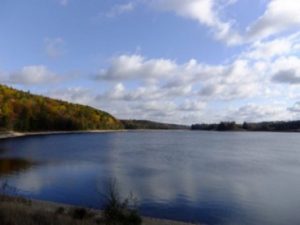 The dam created power for a growing community and it formed a beautiful 191-acre lake that became popular for kayaking, canoeing, fishing, and, around its edges, hiking and cross-country skiing.
The dam created power for a growing community and it formed a beautiful 191-acre lake that became popular for kayaking, canoeing, fishing, and, around its edges, hiking and cross-country skiing.
I lived a short walk down the road and I hiked its edges several times a week, most weeks, for 11 years. Not long after I moved from there to a new home, a new part of my life, and a new vocation, the dam was removed.
A couple years later I made it a point to visit this once familiar and memory-filled place. I wondered what I would feel. I expected a bit of melancholy for the loss of the pond and parts of my life which it had accompanied.
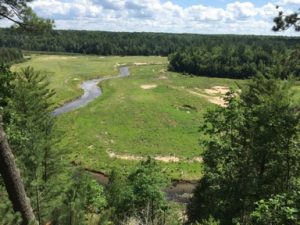
When I returned, a river was snaking through where the pond had been.
I walked down to where the dam used to be.
A spot that now looked like this.
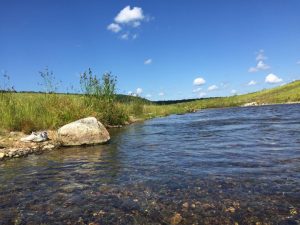
I cast off my shoes, found a stone at the edge, sat and let the clear, now cold water flow over my feet for a good long while.
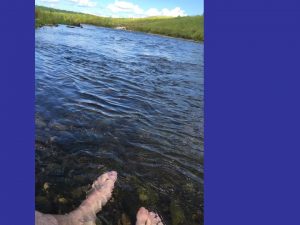
What I felt, to my surprise, and with tears in my eyes, was a very powerful joy. There was a rightness, a trueness to this new-to-me, but original form of the river. As I had known it, the river had been buried beneath the pond all those years, still there, but slowed and masked for several miles by the dammed water.
This, now, was the river as it was meant to be, as it had been, once. The river freed to be itself.
[CHIME]
Being Ourselves
Karyn Packard has offered us several teachings this past year rooted in the Myers-Briggs and Keirsey typologies. Early in each workshop session she has named for us that the point of these tools is not to define us from the outside using someone else’s terms, but rather to help each of us to recognize, honor and live from our “true self.”
Not the adaptive/developed selves we have learned to be for the sake of survival and acceptance, and not the contextual selves that shift with the surroundings and the needs of the moment, but the true self at the center of who we are.
This takes some work, for most of us, takes “many years and places” as May Sarton put it, to become ourselves, especially if we’ve lived a while. We’ve done a lot of adapting and adjusting in our lives, most of us, in order to navigate our worlds. We’ve worn other people’s faces, many of us.
There is a well-known teaching story from the Hassidic tradition in Judaism:
Rabbi Zusya, when he was an old man, said, “In the coming world, they will not ask me: ‘Why were you not Moses?’”
[Or Solomon? Or David? Or as we might put it, “Why were you not Mother Theresa? Or Martin Luther King, Jr.?”]
No, said Rabbi Zusya, “they will ask me: ‘Why were you not Zusya?'” (Palmer 11).”
The mystical edge of every truly religious tradition points us toward our most true self – invites us, nudges us, inspires us, pushes us, tricks us, sometimes, toward realizing our essential self.
But Wait, There’s “More”
The thing is, the surface of religiosity seems to do just the opposite: to ask us to become something different than we are, something more than, someone better than we are.
I confess, am drawn to this ideal of self-improvement, like a moth to a flame, actually, drawn by my personality and by early family and religious training. I am easily seduced by the call to be ever more and better. To be something else, other than who and what I am now.
I have often thought of and described this pull to both accept ourselves as we are and improve ourselves as not only a paradox, in religion and life, but also a polarity, a necessary both/and high wire act requiring constant balancing. A blending of our Universalist heritage which teaches that you are infinitely precious, already loved and saved, and our Unitarian heritage which teaches that you are saved by developing your character. And it is a both/and polarity, but only at the surface, only to the extent we need it to be, and only as a means to an end.
At their best and in the end, all the religious shoulds and oughts, thou shalts and shalt nots, principles and purposes, and spiritual disciplines and practices designed to shape and guide our behavior are like bumpers on a bowling lane – meant to guide our spinning, fishtailing selves toward the center of who we are, without hurting others and without getting sidetracked or lost in the gutters.
The Treasure at Our Feet
There are a number of teaching stories that tell of someone’s grand quest to locate a marvelous treasure. Someone travels the world for years in a failed search, only to return home, eventually, and discover that the treasure they had been seeking was all along buried right where they had started. There seems to be no getting around making the journey.
Alan Watts refers to this as “a journey to where you already are.” He speaks of it in terms of a person’s realization that they are the Universal Self rather than a separate individual. He said,
“…you will visit many other places than the place where you are, and perhaps when you find through some long experience that all the places you go to are not the place you wanted to find, it may occur to you that you were already there in the beginning.”
He goes on: “And that is the Dharma, or “method,” as I prefer to translate the word. That’s the method that all gurus and spiritual teachers fundamentally use (Watts, in Parabola 42:1, pg. 31).”
Gurus have us traveling all over the place until we finally realize that we are already home.
Vocation and Ministry
This Labor Day weekend, I am inviting us to explore the idea of personal vocation and personal ministry through this lens. Lest you who are retirees think that the work is finished, know that David Whyte teaches that this is “a lifelong pilgrimage of identity.” Sometimes, he says, it’s not until retirement that a person is able, at last, to remove the dam – or when it is removed for you – and you are called back to the original essence of who you are.
I am inviting this exploration and your reflection, here at the beginning of the congregation year, because you will be invited into any number of ways to get involved and volunteer and offer who you are in service of this congregation and its mission to create, with courageous love, a world more compassionate, sustainable and just.
And I hope you will be involved fully and healthily. You and your personal gifts are what make this community. Which is why it is so important to give of yourself in ways that are sustainable over time.
Giving from who you most authentically are – from your essential, most true self – will be the giving that sustains and strengthens you at the same time it sustains and strengthens this community. It is the way to serve and grow at the same time. Ideally, this congregation and this tradition will help you to do both.
Parker Palmer says that “The deepest vocational question” – and I would say, in this context, your deepest question of ministry or how you want to serve, “is not ‘What ought I to do […] with my life,’” …my time, my energy, my talent, my money. It’s not about “shoulding” ourselves. The vocational and ministry question is, Palmer says, “the more elemental and demanding, ‘Who am I? What is my nature (Palmer 15)?’”
As you know, this can be difficult to sort out for those of us accustomed/used to offering our adaptive and contextual selves, to wearing other people’s faces, for which we’ve long been rewarded by people.
Let Your Life Speak
To find the clues to your true self beneath the masks and the accumulated layers, Palmer suggests, “Let your life speak.”
Early in his life Palmer took this Quaker phrase to be a call to live up to your “highest values” and their “demanding standards in everything you do.” To listen to the voices from the outside about who you ought to be. It was only 30 years later that he came to hear it as an invitation instead to “let your life tell you what truths you embody, what values you represent.” Let your life tell you who you are most truly.
Thinking of one’s vocation as “an act of will,” he writes, “a grim determination that one’s life will go this way or that whether it wants to or not . . . is an act of violence toward ourselves,” however lofty the motivation (4).
In his words: “Before I can tell my life what I want to do with it, I must listen to my life telling me who I am. I must listen for the truths and values at the heart of my own identity (4-5).”
In the Beginning…and beyond
As a starting place, says Palmer, look to early in your life, when you were closer to your birthright gifts, before you were rewarded or harmed into too much adapting.
Kathryn and Taylor have been sharing stories of their newborn grandchild – [PHOTO] here, at two weeks – already full of a particular easygoing personality. I think of Ixchel Matthews too, [PHOTO] entering the world with a particular set of gifts and a way of being. You who spend time with newborns know this. We arrive with a whole lot of “who” to us when we are born.
Palmer advises, look for hints of your essential self by remembering who you were in the beginning. Maybe not at two weeks old, but early on. Probably the earlier the better.
“We are disabused of original giftedness in the first half of our lives. Then – if we are awake and aware and able to admit our loss – we spend the second half trying to recover and reclaim the gift we once possessed (12).”
You can look for clues, he says, by remembering what you wanted to be when you grew up. This may not be super literal. The clues may need some decoding, in fact may be buried in paradox. (See Palmer’s book, Let Your Life Speak, for more here.)
A Lutheran guide for volunteers for discovering your gifts asks people to complete the sentence: “A gift of which I’ve been aware since my childhood is…”
How would you complete that sentence?
Or you may find clues in someone who has mirrored you back to yourself, though this is tricky because they might have been using a mirror distorted by their own lenses, subtly teaching you to adapt. But there are people who selflessly enough mirror our truth back to us accurately. The second sentence for completion in that Lutheran guide is, “Others tell me I have the gift of…,” or I might put it, “Others tell me I have a gift for… “
How would you complete either of those sentences?
Possible clues to your truest self.
Another approach would be to look for the negative spaces, for when have you burned out in your life. This too can provide clues. David Whyte shares the wisdom he received from a Brother David Steindl-Rast that the antidote to exhaustion and burnout is not necessarily rest, but rather wholeheartedness.
Palmer says that true burnout is a sign not just that we are too busy doing too much, but, more important, that we are not doing the right thing, that we are “violating our own nature,” giving gifts that we can conjure up if necessary, but that we do not inherently possess (49). Ultimately, he says, this is harmful to ourselves and to others.
This is a challenging claim for those of us who are taught that it is a virtue to be what we are not for the sake of others. It is a risky claim in a community that so relies on volunteers.
For all the needs and demands that community life presents, religious community is meant to help us find and give our true selves healthily and well.
The Journey Home
You would think that the journey to where you already are would be simpler. And easier. But as May Sarton reminds us, this spiritual/emotional/intellectual journey can get mess, involve being “dissolved and shaken.” It sometimes takes bottoming out, with no other options, to get us there. If you are bottoming out these days, that may be a silver lining, waiting – painfully opening a window to a truer self.
As the drawdown of the Brown Bridge Pond unfolded, a whole lot of mud was the reality for a time. Mud and stumps. Tree stumps were still there in the pond bed after almost 100 years. Pieces of the original identity remained, not only of the river, but also of what had surrounded it.
There are rewards for being a pond created by the damming of our river. People know that pond, appreciate it, affirm it, love it. Perhaps we do to. At the very least, we become accustomed to it, and moving toward a more true self involves our own losses and grief when we let it go.
At Brown Bridge, green life reclaimed that muddy ground surprisingly quickly, with a little help.
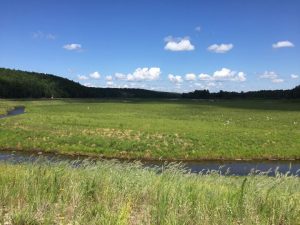
The land along the river where the pond had been was already becoming beautiful and abundant feeling when I saw it several years ago, not long after the dam was removed and the river took on its true form. I look forward to seeing what it looks like now.
I invite you to know, and to participate here at UUCM from the most essential self you can find. I invite you to offer your sacred “no” when a suggested task does not authentically match who you are. Your doing that will help the rest of us to do the same and to hear other people’s “no’s.” I also invite you to ask yourself, “What are your birthright gifts and where might you offer them here?” so that you can offer your sacred “yes” or create an opportunity for that “yes”, and listen for other people’s sacred “yes’s” – voiced and unvoiced – and create opportunities for them.
In the coming weeks we’ll offer additional invitations to reflect on this. And throughout the year we will be offering explicit opportunities to discover more of your true self – in classes and workshops and Soul Matters Circles and committee meetings and Sunday services.
Meanwhile, I encourage you to spend time reflecting on your life so far – on the friends you’ve had, the work you’ve done, the songs you’ve sung, the love you’ve shared – and your earliest visions for your life – listening for what your life tells you about who you are beneath the waters that may have covered your true self.
There’s a river flowing in your soul, in your heart, in your mind, and it’s telling you of the somebody that you are.
[Sing] There’s a river flowin’ in my soul…
Blessed be.
_____________________________
Sources
Palmer, Parker J. Let Your Life Speak: Listening for the Voice of Vocation. San Francisco: Jossey-Bass, 2000.
Watts, Alan. “How To Reach Where You Already Are.” Parabola Spring 2017: 31. Print.
Whyte, David. Crossing the Unknown Sea: Work As a Pilgrimage of Identity. New York: Riverhead Books, 2002.